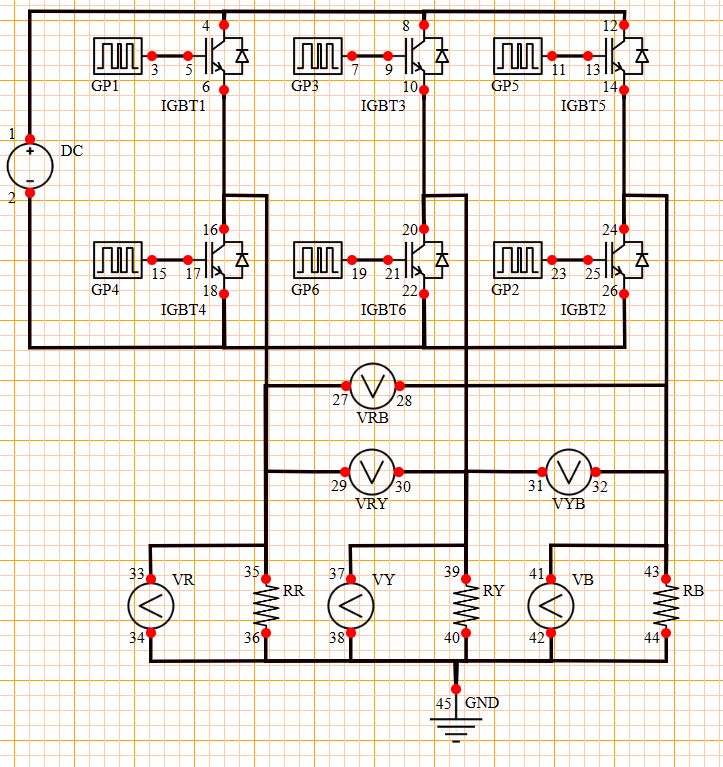Three Phase VSI with 120° and 180° Conduction Mode
STEP 1: Drag and drop the components in the workspace to create the circuit.
Nos of required components:
DC Source – 1, IGBT – 6, Gate Pulse - 6, Resistor - 3, Voltmeter - 6, Ground - 1

STEP 2: Make the connections as per the instructions given below:
(a) (01-04, 03-05, 06-16, 04-08, 07-09, 10-20, 08-12)
(b) (11-13, 14-24, 02-18, 15-17, 18-22, 19-21, 22-26)
(c) (23-25, 16-35, 20-39, 24-43, 35-27, 28-43, 35-29)
(d) (30-39, 39-31, 32-43, 33-35, 34-45, 36-45, 37-39)
(e) (41-43, 38-45, 40-45, 42-45, 44-45)
Note: Click on the wire to delete the connection.
STEP 3: Click on the CHECK button to check the connections.
Note: Right click on the component to open the dialog box to edit the properties of the component.
STEP 4: For 120° Conduction mode Input the values for all the required components (DC Source and Gate Pulses) and the waveform will get plot automatically.
GP1 - 0° to 120°, GP3 - 120° to 240°, GP5 - 240° to 360°, GP4 - 180° to 300°, GP6 - 300° to 420°, GP2 - 60° to 180°.
STEP 5: Now, Click on the ADD button to insert the reading into the observation table.
STEP 6: Now, you can input different values as per your requirement to get the desired waveform.
STEP 7: Repeat Step 5 to again insert the reading into the table and now repeat Steps 6 to 7 to take more readings.
STEP 8: For 180° Conduction mode Input the values for all the required components (DC Source and GatePulses) and the waveform will get plot automatically.
GP1 - 0° to 180°, GP3 - 120° to 300°, GP5 - 240° to 420°, GP4 - 180° to 360°, GP6 - 300° to 480°, GP2 - 60° to 240°.
STEP 9: Now, Repeat Steps 5 to 7.
STEP 10: Click on the PRINT button to take out the print of the webpage.
STEP 11: Click on the RESET button to reload the webpage.
Nos of required components:
DC Source – 1, IGBT – 6, Gate Pulse - 6, Resistor - 3, Voltmeter - 6, Ground - 1

STEP 2: Make the connections as per the instructions given below:
(a) (01-04, 03-05, 06-16, 04-08, 07-09, 10-20, 08-12)
(b) (11-13, 14-24, 02-18, 15-17, 18-22, 19-21, 22-26)
(c) (23-25, 16-35, 20-39, 24-43, 35-27, 28-43, 35-29)
(d) (30-39, 39-31, 32-43, 33-35, 34-45, 36-45, 37-39)
(e) (41-43, 38-45, 40-45, 42-45, 44-45)
Note: Click on the wire to delete the connection.
STEP 3: Click on the CHECK button to check the connections.
Note: Right click on the component to open the dialog box to edit the properties of the component.
STEP 4: For 120° Conduction mode Input the values for all the required components (DC Source and Gate Pulses) and the waveform will get plot automatically.
GP1 - 0° to 120°, GP3 - 120° to 240°, GP5 - 240° to 360°, GP4 - 180° to 300°, GP6 - 300° to 420°, GP2 - 60° to 180°.
STEP 5: Now, Click on the ADD button to insert the reading into the observation table.
STEP 6: Now, you can input different values as per your requirement to get the desired waveform.
STEP 7: Repeat Step 5 to again insert the reading into the table and now repeat Steps 6 to 7 to take more readings.
STEP 8: For 180° Conduction mode Input the values for all the required components (DC Source and GatePulses) and the waveform will get plot automatically.
GP1 - 0° to 180°, GP3 - 120° to 300°, GP5 - 240° to 420°, GP4 - 180° to 360°, GP6 - 300° to 480°, GP2 - 60° to 240°.
STEP 9: Now, Repeat Steps 5 to 7.
STEP 10: Click on the PRINT button to take out the print of the webpage.
STEP 11: Click on the RESET button to reload the webpage.
